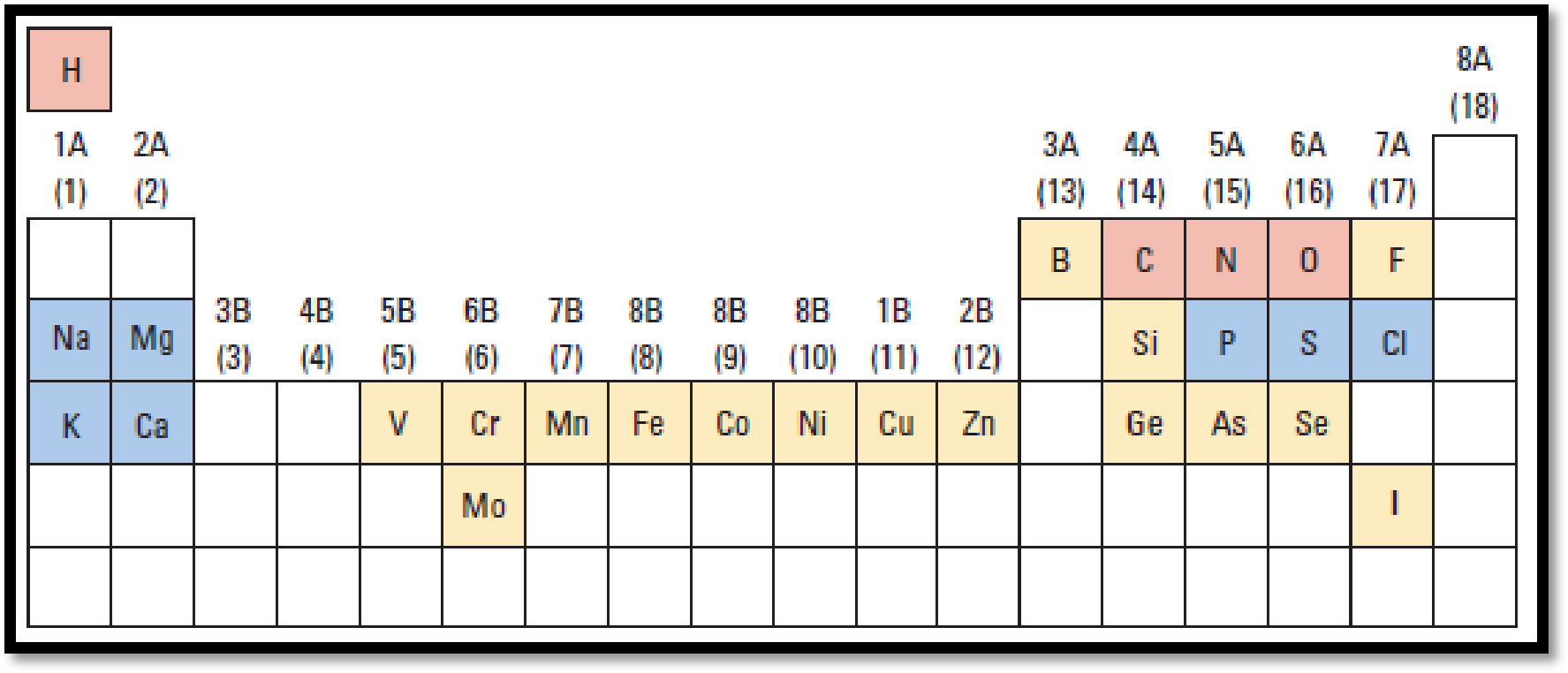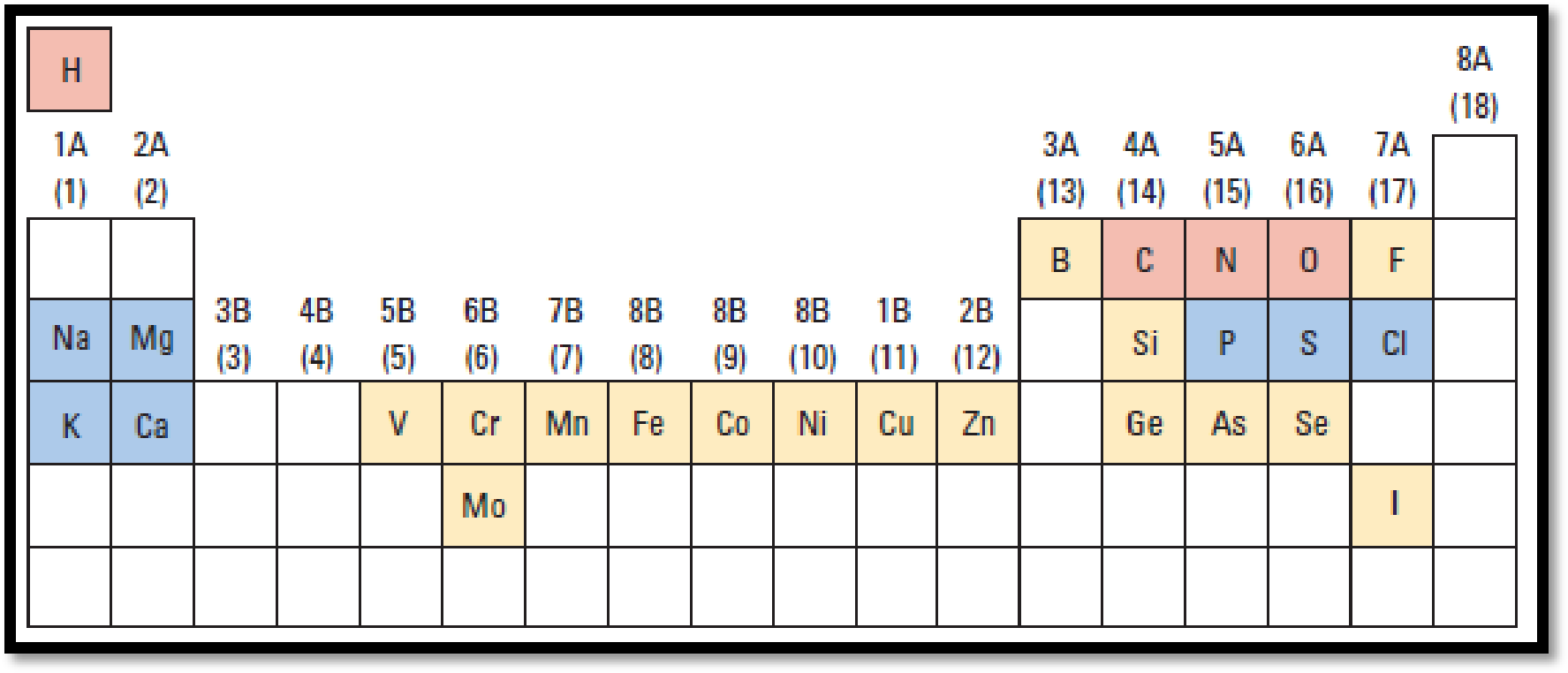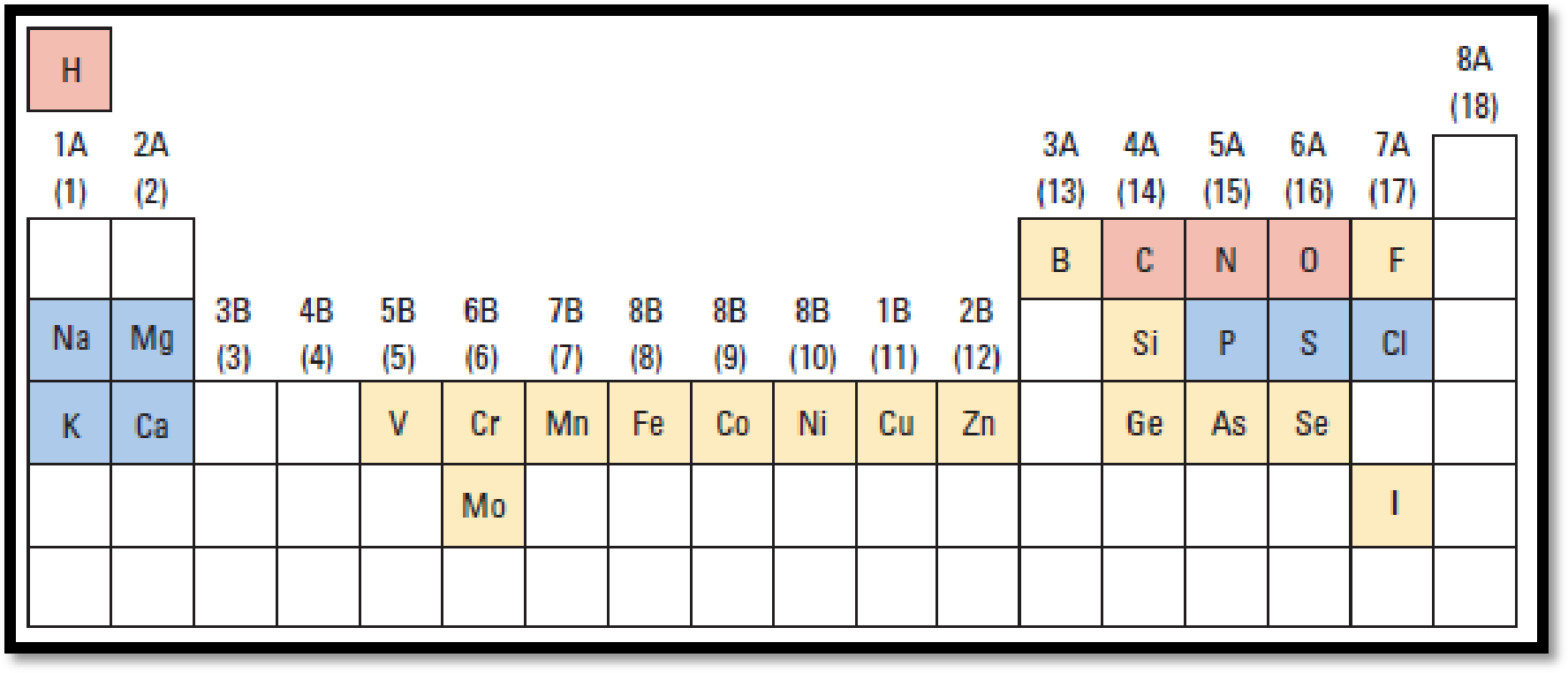
Chemistry: The Molecular Science
5th Edition
ISBN: 9781285199047
Author: John W. Moore, Conrad L. Stanitski
Publisher: Cengage Learning
expand_more
expand_more
format_list_bulleted
Question
Chapter 1.14, Problem 1.13E
(a)
Interpretation Introduction
Interpretation:
Using the given figure, the essential nonmetals has to be identified.

Figure 1
(b)
Interpretation Introduction
Interpretation:
Using the given figure, the essential alkaline-earth metals has to be identified.

Figure 1
(c)
Interpretation Introduction
Interpretation:
Using the given figure, the essential halide ions has to be identified.

Figure 1
(d)
Interpretation Introduction
Interpretation:
Using the given figure, four essential

Figure 1
Expert Solution & Answer
Want to see the full answer?
Check out a sample textbook solution
Students have asked these similar questions
(a) How many elements are found in period 4 in the periodic table? (b) How many elements are found in group 4A (or 14)?
Chlorine reacts with oxygen to form Cl2O7. (a) What is the name of this product (see Table 2.6)? (b) Write a balanced equation for the formation of Cl2O7(l) from the elements. (c) Under usual conditions, Cl2O7 is a colorless liquid with a boiling point of 81℃. Is this boiling point expected or surprising? (d) Would you expect Cl2O7 to be more reactive toward H+(aq) or OH− (aq)? Explain. (e) If the oxygen in Cl2O7 is considered to have the -2 oxidation state, what is the oxidation state of the Cl? What is the electron configuration of Cl in this oxidation state?
D1. One atom has 20 protons and a mass number of 44. Another atom has 20 protons and a mass number of 40.
(a) What is the similarity and dissimilarity in these atoms?
(b) The atom combines with phosphate ion. Write the chemical formula and chemical name of the compound.
(c) What is the valency and oxidation number of an atom in the elemental form?
Chapter 1 Solutions
Chemistry: The Molecular Science
Ch. 1.4 - Temperature
Determine which temperature is higher,...Ch. 1.4 - Prob. 1.2CECh. 1.4 - Identify each physical property and physical...Ch. 1.5 - SI Units and Prefixes
Show mathematically that 1...Ch. 1.5 - Prob. 1.5ECh. 1.5 - Calculate the volume occupied by a 4.33-g sample...Ch. 1.6 - Identify the chemical and physical changes that...Ch. 1.8 - Prob. 1.2PSPCh. 1.8 - Prob. 1.7ECh. 1.9 - Prob. 1.8CE
Ch. 1.11 - Draw a nanoscale representation and a symbolic...Ch. 1.13 - Prob. 1.9ECh. 1.13 - Prob. 1.10ECh. 1.13 - Prob. 1.11ECh. 1.13 - Prob. 1.12ECh. 1.14 - Prob. 1.13ECh. 1 - Prob. 1QRTCh. 1 - Choose an object in your room, such as a cell...Ch. 1 - Prob. 3QRTCh. 1 - Prob. 4QRTCh. 1 - Prob. 5QRTCh. 1 - Prob. 6QRTCh. 1 - Which of these statements are qualitative? Which...Ch. 1 - Which of the these statements are qualitative?...Ch. 1 - The elements sulfur and bromine are shown in the...Ch. 1 - In the accompanying photo, you see a crystal of...Ch. 1 - Prob. 13QRTCh. 1 - Prob. 14QRTCh. 1 - Prob. 15QRTCh. 1 - Suppose a room is 18 m long, 15 m wide, and the...Ch. 1 - Prob. 17QRTCh. 1 - Prob. 18QRTCh. 1 - Prob. 19QRTCh. 1 - Prob. 20QRTCh. 1 - Perform these calculations and express the result...Ch. 1 - Prob. 22QRTCh. 1 - A 105.5-g sample of a metal was placed into water...Ch. 1 - Prob. 24QRTCh. 1 - An unknown sample of a metal is 1.0 cm thick, 2.0...Ch. 1 - Calculate the volume of a 23.4-g sample of...Ch. 1 - Calculate the mass of a sodium chloride crystal if...Ch. 1 - Calculate the volume occupied by a 4.33-g sample...Ch. 1 - In each case, identify the italicized property as...Ch. 1 - Prob. 30QRTCh. 1 - In each case, describe the change as a chemical or...Ch. 1 - In each case, describe the change as a chemical or...Ch. 1 - Prob. 33QRTCh. 1 - Prob. 34QRTCh. 1 - Prob. 35QRTCh. 1 - Identify each of these as a homogeneous or a...Ch. 1 - Devise and describe an experiment to (a) Separate...Ch. 1 - Prob. 38QRTCh. 1 - For each of the changes described, decide whether...Ch. 1 - For each of the changes described, decide whether...Ch. 1 - Classify each of these as an element, a compound,...Ch. 1 - Prob. 42QRTCh. 1 - Prob. 43QRTCh. 1 - Prob. 44QRTCh. 1 - Prob. 45QRTCh. 1 - Prob. 46QRTCh. 1 - Prob. 47QRTCh. 1 - Prob. 48QRTCh. 1 - Prob. 49QRTCh. 1 - Prob. 50QRTCh. 1 - Prob. 51QRTCh. 1 - Prob. 52QRTCh. 1 - Prob. 53QRTCh. 1 - Prob. 54QRTCh. 1 - Write a chemical formula for each substance, and...Ch. 1 - Prob. 56QRTCh. 1 - Prob. 57QRTCh. 1 - Prob. 58QRTCh. 1 - Prob. 59QRTCh. 1 - Prob. 60QRTCh. 1 - Prob. 61QRTCh. 1 - Prob. 62QRTCh. 1 - Name and give symbols for three transition metals...Ch. 1 - Name two halogens. Look up each of your choices in...Ch. 1 - Prob. 65QRTCh. 1 - Prob. 66QRTCh. 1 - Prob. 67QRTCh. 1 - Prob. 68QRTCh. 1 - Prob. 69QRTCh. 1 - Prob. 70QRTCh. 1 - Prob. 71QRTCh. 1 - Prob. 72QRTCh. 1 - Prob. 73QRTCh. 1 - Prob. 74QRTCh. 1 - Prob. 75QRTCh. 1 - Prob. 76QRTCh. 1 - The label on a bale of mulch indicates a volume of...Ch. 1 - Prob. 78QRTCh. 1 - Prob. 79QRTCh. 1 - The cancer drug cisplatin contains 65.0% platinum....Ch. 1 - Prob. 81QRTCh. 1 - The density of gaseous helium at 25 C and normal...Ch. 1 - Prob. 83QRTCh. 1 - Prob. 84QRTCh. 1 - Prob. 85QRTCh. 1 - You can figure out whether a substance floats or...Ch. 1 - Prob. 87QRTCh. 1 - Prob. 88QRTCh. 1 - Prob. 89QRTCh. 1 - Prob. 90QRTCh. 1 - Prob. 91QRTCh. 1 - Which two elements from this list exhibit the...Ch. 1 - Prob. 93QRTCh. 1 - Prob. 94QRTCh. 1 - Prob. 95QRTCh. 1 - Prob. 96QRTCh. 1 - Prob. 97QRTCh. 1 - Prob. 98QRTCh. 1 - Prob. 99QRTCh. 1 - Using Table 1.1, but without using your...Ch. 1 - Prob. 101QRTCh. 1 - At 25 C the density of water is 0.997 g/mL,...Ch. 1 - Prob. 103QRTCh. 1 - Prob. 104QRTCh. 1 - Prob. 105QRTCh. 1 - Prob. 106QRTCh. 1 - Answer these questions using figures (a) through...Ch. 1 - Prob. 108QRTCh. 1 - Prob. 109QRTCh. 1 - Prob. 110QRTCh. 1 - Prob. 111QRTCh. 1 - Prob. 112QRTCh. 1 - Prob. 113QRTCh. 1 - Prob. 114QRTCh. 1 - Prob. 115QRTCh. 1 - Prob. 116QRTCh. 1 - Prob. 118QRTCh. 1 - Prob. 119QRTCh. 1 - Prob. 120QRTCh. 1 - Prob. 121QRTCh. 1 - Prob. 122QRTCh. 1 - The element magnesium reacts with the element...Ch. 1 - Prob. 124QRTCh. 1 - Prob. 125QRTCh. 1 - When 12.6 g calcium carbonate (the principal...Ch. 1 - Prob. 127QRTCh. 1 - Suppose you are trying to get lemon juice and you...Ch. 1 - Prob. 1.BCPCh. 1 - Prob. 1.CCPCh. 1 - Prob. 1.DCPCh. 1 - Prob. 1.ECPCh. 1 - Some scientists think there are living things...Ch. 1 - Prob. 1.GCPCh. 1 - Prob. 1.HCP
Knowledge Booster
Learn more about
Need a deep-dive on the concept behind this application? Look no further. Learn more about this topic, chemistry and related others by exploring similar questions and additional content below.Similar questions
- why are neutrons preferred to protons when preparing new isotopes of the lighter elements?If a salt bridge contains KNO3 as its electrolyte, which ions diffuse into solution in the cathode compartment of the galvanic cell? explain your answer.arrow_forwardWrite a balanced equation for the following by inserting the correct coefficients (if a coefficient = 1, enter "1" in the provided box). Ca3(PO2() + SiO:() +C) – C(s) → CaSiO3(1) + || CO(g) + +P.()arrow_forwardGive the chemical formula for (a) chlorite ion, (b) chlorideion, (c) chlorate ion, (d) perchlorate ion, (e) hypochlorite ion.arrow_forward
- 3. Consider the nickel salt: (NH4 )2Ni(SO4 )2 ·y H2O (Ammonium Nickel Sulfate Hydrate), where y is the number of coordinated waters. (a) Assuming that the product is anhydrous (y = 0), what is the theoretical yield of ammonium nickel sulfate from 1.500 g of Ni (s)? (b) The actual yield of product was 9.640 g - obviously containing coordinated water. The product was then heated strongly until all the water had been driven off. The resulting anhydrous salt had mass 7.000 g. What is the value of y? (c) Based on the mass of the anhydrous product (7.000 g), what is the % yield of the reaction?arrow_forward2. a) b)arrow_forward(a) What is a hydrocarbon? (b) Butane is the alkane with a chain of four carbon atoms. Write a structural formula for this compound and determine its molecular and empirical formulas.arrow_forward
- What are the two most abundant elements by mass in the earths crust, oceans, and atmosphere? Does this make sense? Why? What are the four most abundant elements by mass in the human body? Does this make sense? Why?arrow_forwardChlorine exists mainly as two isotopes, 37Cl and 33Cl. Which is more abundant? How do you know?arrow_forwardOne application of conductive polymers is in photovoltaic solar cells. Such devices have traditionally been silicon based. What possible advantages might conducting polymers offer?arrow_forward
arrow_back_ios
arrow_forward_ios
Recommended textbooks for you
 Chemistry: The Molecular ScienceChemistryISBN:9781285199047Author:John W. Moore, Conrad L. StanitskiPublisher:Cengage Learning
Chemistry: The Molecular ScienceChemistryISBN:9781285199047Author:John W. Moore, Conrad L. StanitskiPublisher:Cengage Learning General Chemistry - Standalone book (MindTap Cour...ChemistryISBN:9781305580343Author:Steven D. Gammon, Ebbing, Darrell Ebbing, Steven D., Darrell; Gammon, Darrell Ebbing; Steven D. Gammon, Darrell D.; Gammon, Ebbing; Steven D. Gammon; DarrellPublisher:Cengage Learning
General Chemistry - Standalone book (MindTap Cour...ChemistryISBN:9781305580343Author:Steven D. Gammon, Ebbing, Darrell Ebbing, Steven D., Darrell; Gammon, Darrell Ebbing; Steven D. Gammon, Darrell D.; Gammon, Ebbing; Steven D. Gammon; DarrellPublisher:Cengage Learning Chemistry & Chemical ReactivityChemistryISBN:9781337399074Author:John C. Kotz, Paul M. Treichel, John Townsend, David TreichelPublisher:Cengage Learning
Chemistry & Chemical ReactivityChemistryISBN:9781337399074Author:John C. Kotz, Paul M. Treichel, John Townsend, David TreichelPublisher:Cengage Learning Chemistry & Chemical ReactivityChemistryISBN:9781133949640Author:John C. Kotz, Paul M. Treichel, John Townsend, David TreichelPublisher:Cengage Learning
Chemistry & Chemical ReactivityChemistryISBN:9781133949640Author:John C. Kotz, Paul M. Treichel, John Townsend, David TreichelPublisher:Cengage Learning Chemistry: Principles and PracticeChemistryISBN:9780534420123Author:Daniel L. Reger, Scott R. Goode, David W. Ball, Edward MercerPublisher:Cengage Learning
Chemistry: Principles and PracticeChemistryISBN:9780534420123Author:Daniel L. Reger, Scott R. Goode, David W. Ball, Edward MercerPublisher:Cengage Learning Introduction to General, Organic and BiochemistryChemistryISBN:9781285869759Author:Frederick A. Bettelheim, William H. Brown, Mary K. Campbell, Shawn O. Farrell, Omar TorresPublisher:Cengage Learning
Introduction to General, Organic and BiochemistryChemistryISBN:9781285869759Author:Frederick A. Bettelheim, William H. Brown, Mary K. Campbell, Shawn O. Farrell, Omar TorresPublisher:Cengage Learning

Chemistry: The Molecular Science
Chemistry
ISBN:9781285199047
Author:John W. Moore, Conrad L. Stanitski
Publisher:Cengage Learning

General Chemistry - Standalone book (MindTap Cour...
Chemistry
ISBN:9781305580343
Author:Steven D. Gammon, Ebbing, Darrell Ebbing, Steven D., Darrell; Gammon, Darrell Ebbing; Steven D. Gammon, Darrell D.; Gammon, Ebbing; Steven D. Gammon; Darrell
Publisher:Cengage Learning

Chemistry & Chemical Reactivity
Chemistry
ISBN:9781337399074
Author:John C. Kotz, Paul M. Treichel, John Townsend, David Treichel
Publisher:Cengage Learning

Chemistry & Chemical Reactivity
Chemistry
ISBN:9781133949640
Author:John C. Kotz, Paul M. Treichel, John Townsend, David Treichel
Publisher:Cengage Learning

Chemistry: Principles and Practice
Chemistry
ISBN:9780534420123
Author:Daniel L. Reger, Scott R. Goode, David W. Ball, Edward Mercer
Publisher:Cengage Learning

Introduction to General, Organic and Biochemistry
Chemistry
ISBN:9781285869759
Author:Frederick A. Bettelheim, William H. Brown, Mary K. Campbell, Shawn O. Farrell, Omar Torres
Publisher:Cengage Learning
What are CHNOPS? These Chemical Elements = 98% of Life | Biology | Biochemistry; Author: Socratica;https://www.youtube.com/watch?v=w90wFlR53VM;License: Standard YouTube License, CC-BY